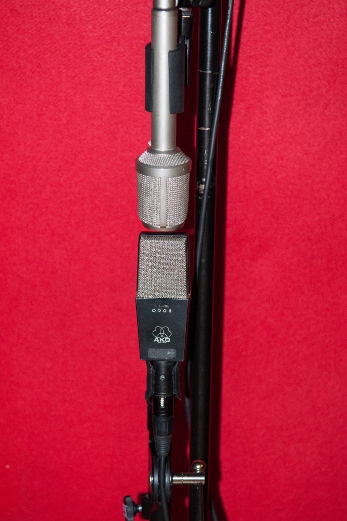Recording Refresher #1 — Stop Worrying, and Choose the Right Microphone
As engineers, we are constantly tasked with making quick, important decisions in the early stages of tracking that heavily influence the final outcome.

AKG C-414 on a kick drum with a solid front head. Not for big rock kick sounds, but this session had a softer, acoustic feel. Lots of bloom, resonance, and bleed. (click to enlarge)
There are many factors that are out of our control and we must work within constraints. We often cannot control the room, the players and to some extent, the instruments themselves.
Understanding our limitations (and inherent strengths) is key towards bringing recordings to the next level. Often the first avenue where we can exercise ultimate control is at the microphone.
Expensive mics are never mandatory. Many amazing records – more than you may realize – have been made with less-than-legendary microphones. The key is in choosing the right mic for the job and using it to the best of its abilities.
What You Are NOT Listening To
Frequency response is the most often discussed facet of a microphone, but will actually play less into our decision-making process than you may think. Far more important for my money is polar pattern and placement; both of which go hand in hand.
Microphones exhibit what we refer to as directionality. That is, where the microphone is most sensitive and accurate in its reproduction of sound vs. the point of maximum attenuation.
Read that last part again. It’s important to understand that a mic’s point of maximum rejection is AT LEAST as important as it’s on-axis response.
To put it bluntly, there a million ways to point a mic at a snare drum that can make the snare sound great; very few that will minimize spill from the hi-hats.
Spill can come from any direction and be caused by early reflections in the room or other point sources/instruments. It’s an idea that I come across time and time again in the search for balance, but it remains true: We do not exist in a vacuum and every choice you make will affect your overall recording.
Listening in isolation will only give you part of the story, so be sure to avoid aiming for “Solo Glory”. The goal here is to find the balance point where the blend of our desired sound melds nicely with spill. Try to aim for control rather than elimination. Ambience is not evil, but it can definitely turn around and bite you!
Off-Axis is Not the Enemy

RCA 74b on both toms. I love figure-eight pattern for so many things. The null point on bi-directional mics is fantastic. Great for cymbal rejection in this case. (click to enlarge)
All directional microphones pick up sound most effectively at what we refer to as 0 degrees, or on-axis. This is where the mic will exhibit the most accurate pickup, especially in regards to the treble range.
High frequencies have very little power, and are very directional in nature. In other words, they give our ears many subtle cues about distance and intimacy.
Many engineers reach for an equalizer if the sound isn’t up to par. However, equalizers are like band-aids: I will absolutely use one if I needed, but it’s much better to just avoid that need in the first place! Rotating a mic off-axis will roll off the high frequencies first. It’s like having an EQ built right in to your mic!
The default setting is to just point a mic directly at a source and be done. And often this works great, but with a little planning and thought, we can add layers and depth to our recordings. For example, when a singer wants to record background vocals or double themselves, I will often move them off-axis. This allows the lead to shine and most importantly, sounds good right out of the gate.
That Feeling of Closeness.
If you want your mix to really grab people’s attention, there can’t be fighting within the song itself. Not every instrument can be important all the time.
Great sounds are all about perspective and reference. If you want something in this song to be right up front, there needs to be a reference point of something else being far away. In other words, if everything is important, nothing is.
As we move a source closer to a mic, it will sound as though it is closer and more upfront. Use this to your advantage. Conversely, I often record rhythm and backing tracks from further away, so they don’t compete with leads. Additionally, polar patterns affect this well with cardioid appearing closer than bi-directional or omni.
A Million Ways to Try
Using just the above info, a great recording can be made under less than ideal circumstances. That’s useful since most of us don’t get to operate at world-class studios all day (YET!).
Get in there, listen, move that mic around and most importantly…have fun!
Rich Crescenti is a freelance engineer, producer, teacher, and drummer who works out of several studios in NYC, helping bands make unique recordings. Rich also hits things with sticks for the Brooklyn-based rock band Bugs in the Dark.

Two Coles 4038 mics using the Faulkner Stereo technique. Although typically used in narrow rooms, I’m using it here to provide depth without an overly wide stereo image. Ribbons as overheads give a very smooth and papery sound that blends well.

AKG C-414 and Nuemann KM86 using mid-side. Allows for different microphones and great mono compatibility.

Full view of the drum kit mics. I started with the overheads and built the kit sound from there, changing and moving mics several times.
Please note: When you buy products through links on this page, we may earn an affiliate commission.






